产品安全数据表
- 格式:doc
- 大小:25.00 KB
- 文档页数:3
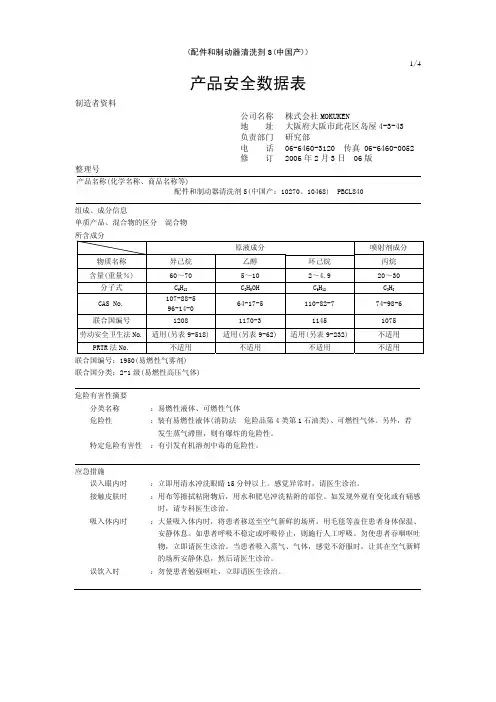
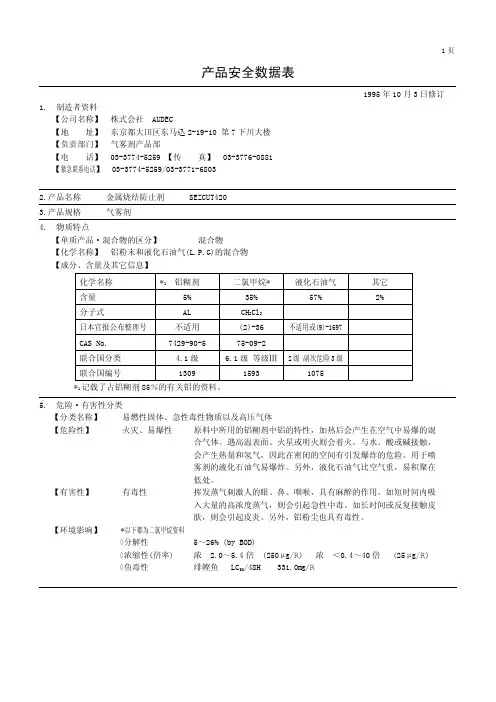
产品安全数据表1995年10月3日修订 1. 制造者资料【公司名称】 株式会社 AUDEC【地 址】 东京都大田区东马込2-19-10 第7下川大楼【负责部门】 气雾剂产品部【电 话】 03-3774-5259 【传 真】 03-3776-0881【紧急联系电话】 03-3774-5259/03-3771-68032.产品名称 金属烧结防止剂 SEZCUT4203.产品规格 气雾剂4. 物质特点【单质产品·混合物的区分】 混合物【化学名称】 铝粉末和液化石油气(L.P.G)的混合物【成分、含量及其它信息】化学名称 *1 铝糊剂 二氯甲烷* 液化石油气 其它含量 5% 35% 57% 2%分子式 AL CH2Cl2日本官报公布整理号 不适用 (2)-36 不适用或(9)-1697CAS No. 7429-90-5 75-09-2联合国分类 4.1级 6.1级 等级Ⅲ2级 副次危险3级联合国编号 1309 1593 1075*1记载了占铝糊剂85%的有关铝的资料。
5. 危险·有害性分类【分类名称】 易燃性固体、急性毒性物质以及高压气体【危险性】 火灾、易爆性 【有害性】 有毒性【环境影响】 *以下都为二氯甲烷资料◇分解性◇浓缩性(倍率)◇鱼毒性 原料中所用的铝糊剂中铝的特性,加热后会产生在空气中易爆的混合气体。
遇高温表面、火星或明火则会着火。
与水、酸或碱接触,会产生热量和氢气,因此在密闭的空间有引发爆炸的危险。
用于喷雾剂的液化石油气易爆炸。
另外,液化石油气比空气重,易积聚在低处。
挥发蒸气刺激人的眼、鼻、咽喉,具有麻醉的作用。
如短时间内吸入大量的高浓度蒸气,则会引起急性中毒。
如长时间或反复接触皮肤,则会引起皮炎。
另外,铝粉尘也具有毒性。
5~26% (by BOD)浓 2.0~5.4倍 (250μg/R) 浓 <0.4~40倍 (25μg/R) 绯鲣鱼 LC50/48H 331.0mg/R6. 应急处理【接触皮肤时】 【误入眼内时】 【吸入体内时】 【误饮入时】 脱下污染的衣服,用大量清水冲洗受到接触过的皮肤。
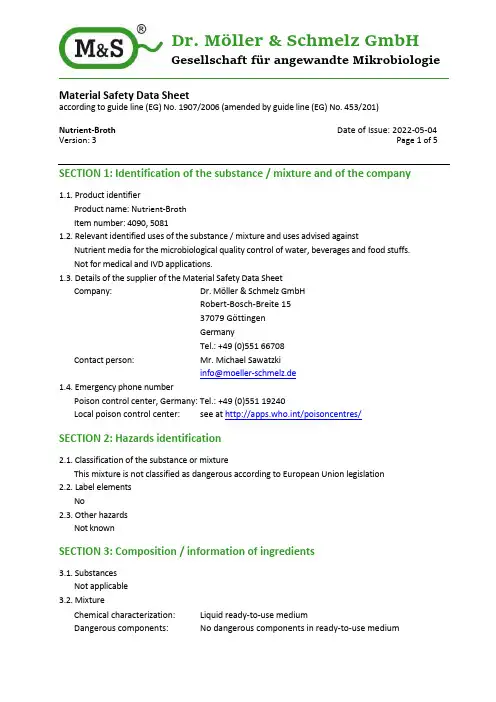
Material Safety Data Sheetaccording to guide line (EG) No. 1907/2006 (amended by guide line (EG) No. 453/201)Nutrient-Broth Date of Issue: 2022-05-04Version: 3 Page 1 of 5SECTION 1: Identification of the substance / mixture and of the company1.1. Product identifierProduct name: Nutrient-BrothItem number: 4090, 50811.2. Relevant identified uses of the substance / mixture and uses advised againstNutrient media for the microbiological quality control of water, beverages and food stuffs.Not for medical and IVD applications.1.3. Details of the supplier of the Material Safety Data SheetCompany: Dr. Möller & Schmelz GmbHRobert-Bosch-Breite 1537079 GöttingenGermanyTel.: +49 (0)551 66708Contact person: Mr. Michael Sawatzki***********************1.4. Emergency phone numberPoison control center, Germany: Tel.: +49 (0)551 19240Local poison control center: see at http://apps.who.int/poisoncentres/SECTION 2: Hazards identification2.1. Classification of the substance or mixtureThis mixture is not classified as dangerous according to European Union legislation2.2. Label elementsNo2.3. Other hazardsNot knownSECTION 3: Composition / information of ingredients3.1. SubstancesNot applicable3.2. MixtureChemical characterization: Liquid ready-to-use mediumDangerous components: No dangerous components in ready-to-use mediumMaterial Safety Data Sheetaccording to guide line (EG) No. 1907/2006 (amended by guide line (EG) No. 453/201)Nutrient-Broth Date of Issue: 2022-05-04Version: 3 Page 2 of 5SECTION 4: First-aid measures4.1. Description of the first-aid measuresGeneral advice: No special measures necessaryAfter inhalation: Fresh airAfter skin contact: Wash off with plenty of waterAfter eye contact: Rinse out with plenty of waterAfter swallowing: Wash out mouth and drink water, consult doctor if feelingUnwell4.2. Most important symptoms and effects, both acute and delayedNone known4.3. Indication of any immediate medical attention and special treatment neededNone knownSECTION 5: Firefighting measures5.1. Extinguishing mediaWater, foam, dry powder, carbon dioxide (CO2)5.2. Special hazards arising from the substance or mixtureNone known5.3. Advice for firefightersNo special measures requiredSECTION 6: Accidental release measures6.1. Personal precautions, protective equipment and emergency proceduresNo special measures required6.2. Environmental precautionsNo special measures required6.3. Methods and materials for containment and cleaning upNo special measures required6.4. Reference to other sectionsNoneSECTION 7: Handling and storage7.1. Precautions for safe handlingNoneMaterial Safety Data Sheetaccording to guide line (EG) No. 1907/2006 (amended by guide line (EG) No. 453/201)Nutrient-Broth Date of Issue: 2022-05-04Version: 3 Page 3 of 57.2. Conditions for safe storage, including any incompatibilitiesStore dark and dry at + 4 °C to + 12 °C7.3. Specific end usesNoneSECTION 8: Exposure controls / personal protection8.1. Control parametersNone8.2. Exposure controlsGeneral measures: Follow the usual procedures for handling chemicals.Hygiene measures: Wash hands after working with the mixtureRespiratory protection: Not necessaryHand protection: Not necessaryEye protection: Safety glassesSECTION 9: Physical and chemical properties9.1. Information on basic physical and chemical propertiesForm: LiquidColor: BeigeOdor: Peptone-likepH: 7.2 ± 0.2Melting point: No information availableBoiling point: 100 °CFlash point: No information availableEvaporation rate: No information availableFlammability: No information availableExplosion limit: No information availableVapor pressure: No information availableVapor density: No information availableRelative density: No information availableWater solubility: No information availablePartition coefficient No information availablen-octanol / waterAutoignition temperature: No information availableMaterial Safety Data Sheetaccording to guide line (EG) No. 1907/2006 (amended by guide line (EG) No. 453/201)Nutrient-Broth Date of Issue: 2022-05-04Version: 3 Page 4 of 5Decomposition temperature: No information availableViscosity: No information availableExplosive properties: No information availableOxidizing properties: No information available9.2. Other dataNoneSECTION 10: Stability and reactivity10.1. ReactivityNo information available10.2. Chemical stabilityNo information available10.3. Possibility of hazardous reactionsNo information available10.4. Conditions to avoidNo information available10.5. Incompatible materialsNo information available10.6. Hazardous decompositions productsNo information availableSECTION 11: Toxicological information11.1. Information on toxicological effectsNo information availableSECTION 12: Ecological information12.1. ToxicityNo information available12.2. Persistence and degradabilityNo information available12.3. Bioaccumulative potentialNo information available12.4. Mobility in soilNo information availableMaterial Safety Data Sheetaccording to guide line (EG) No. 1907/2006 (amended by guide line (EG) No. 453/201)Nutrient-Broth Date of Issue: 2022-05-04Version: 3 Page 5 of 512.5. Result of PBT and vPvB assessmentNo information available12.6. Other adverse effectNo information availableSECTION 13: Disposal considerations13.1. Waste treatment methodsProduct: Used products shall be sterilized and are then to be treatedaccording to the regulations of the local authorities.Package: Empty packages can be delivered to the municipal wastetreatment.SECTION 14: Transport classificationNot classified as dangerous in the meaning of transport regulationsSECTION 15: Regulatory information15.1. Safety, health and environmental regulations / legislation specific for the substance or mixtureEU 453/2010EU 1272/2008WGK Classification Water endangering class = non-hazardous to waters15.2. Chemical safety assessmentFor this product a chemical safety assessment was not carried out.SECTION 16: Other informationNational and local guidelines are to be followed.The information provided in the material safety data sheet is based on our present state of our best knowledge and is to characterize our product regarding appropriate precautions. We shall not be held liable for the sufficiency, correctness, absence of errors and appropriateness of this information and its use. The assessment for suitability of the product for a certain application is solely in the responsibility of the end-user. We do not accept liability for any damage resulting from handling or from contact with the above product.The above information is subject to modifications and amendments, i.e. caused by changes of legal regulations.。
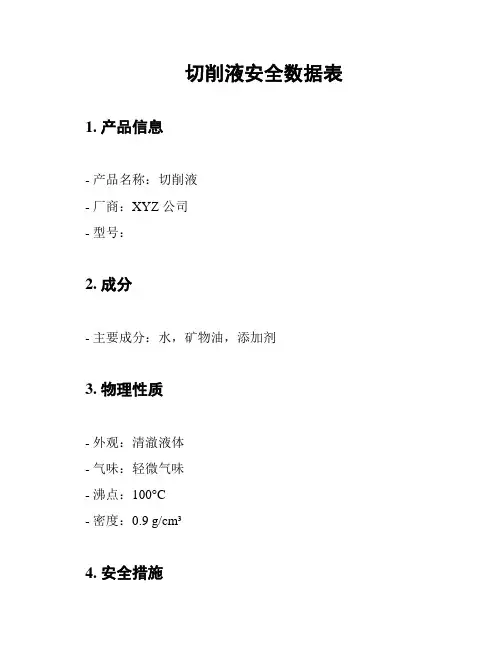
切削液安全数据表1. 产品信息
- 产品名称:切削液
- 厂商:XYZ 公司
- 型号:
2. 成分
- 主要成分:水,矿物油,添加剂
3. 物理性质
- 外观:清澈液体
- 气味:轻微气味
- 沸点:100°C
- 密度:0.9 g/cm³
4. 安全措施
- 避免长时间接触皮肤,使用时佩戴个人防护装备。
- 不可用于食品加工。
- 避免与强氧化剂、酸、碱等物质接触。
5. 急救措施
- 气味强烈或出现不适时,移到通风处休息。
- 不慎接触皮肤,立即用大量清水冲洗,并就医寻求进一步帮助。
- 不慎吸入,立即移至空气新鲜处,并就医寻求进一步帮助。
6. 灭火措施
- 使用干粉灭火器进行灭火。
- 切勿使用水来灭火。
7. 存储和运输
- 存放于阴凉、通风处,远离火源和热源。
- 避免与食品、饮料等放置在一起。
- 运输时避免剧烈震动和颠簸。
8. 应急处置措施
- 发生泄漏时,立即采取吸气剂进行覆盖和吸附。
- 不得将废弃物排入污水或土壤中,应依法处置。
以上是切削液的安全数据表,请根据需要采取相应的安全措施和操作步骤。
参考文献
XYZ 公司内部文件。
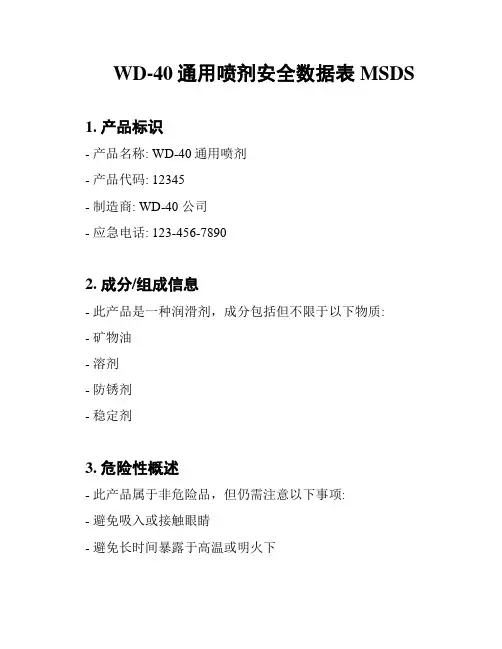
WD-40通用喷剂安全数据表MSDS1. 产品标识- 产品名称: WD-40通用喷剂- 产品代码: 12345- 制造商: WD-40 公司- 应急电话: 123-456-78902. 成分/组成信息- 此产品是一种润滑剂,成分包括但不限于以下物质:- 矿物油- 溶剂- 防锈剂- 稳定剂3. 危险性概述- 此产品属于非危险品,但仍需注意以下事项:- 避免吸入或接触眼睛- 避免长时间暴露于高温或明火下4. 急救措施- 吸入: 将患者移到新鲜空气中,如有不适,立即就医。
- 眼部接触: 用大量清水冲洗至少15分钟,如有不适,立即就医。
- 皮肤接触: 取下污染的衣物,用肥皂和水彻底清洗,如有不适,立即就医。
- 摄入: 不要催吐,立即就医。
5. 防护措施- 储存: 存放在阴凉、干燥的地方,远离明火和高温。
- 使用: 避免吸入喷雾,使用时保持通风良好。
6. 意外泄漏处置- 将泄漏物收集起来,避免进入下水道或排水系统。
- 使用油吸附剂清除泄漏物,然后用肥皂和水清洗。
7. 操作处置和存储要求- 使用时避免吸入喷雾,避免接触皮肤和眼睛。
- 存放在阴凉、干燥的地方,远离明火和高温。
8. 暴露控制/个体防护- 通风: 使用时保持通风良好。
- 呼吸防护: 如通风不足,佩戴防护口罩。
- 眼部防护: 避免喷雾进入眼睛,如有必要,佩戴安全眼镜。
- 皮肤防护: 避免长时间接触皮肤,如有必要,佩戴防护手套。
9. 物理和化学性质- 外观: 透明液体- pH 值: 中性- 沸点: 200°C- 闪点: 60°C- 自燃温度: 400°C10. 稳定性和反应活性- 稳定性: 稳定于常温下的正常使用条件下。
- 反应活性: 避免与强氧化剂接触。
11. 毒理学信息- 急性毒性: 无明显急性毒性。
- 皮肤刺激性: 可能对过敏者产生轻微刺激。
- 眼刺激性: 可能对眼睛产生轻微刺激。
- 吸入毒性: 吸入过量可能导致头晕和呼吸不畅。
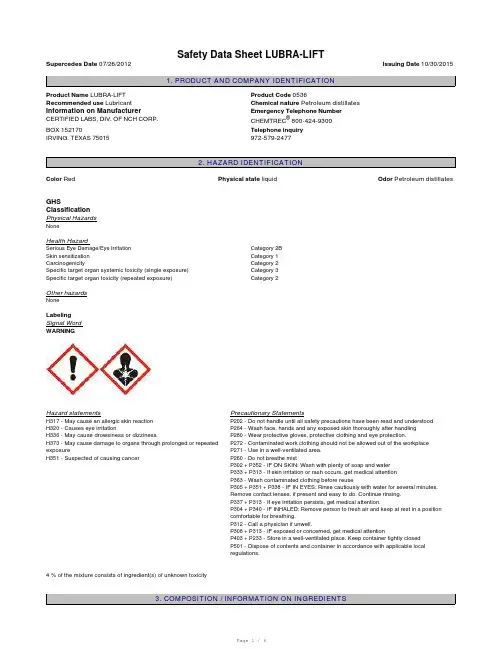
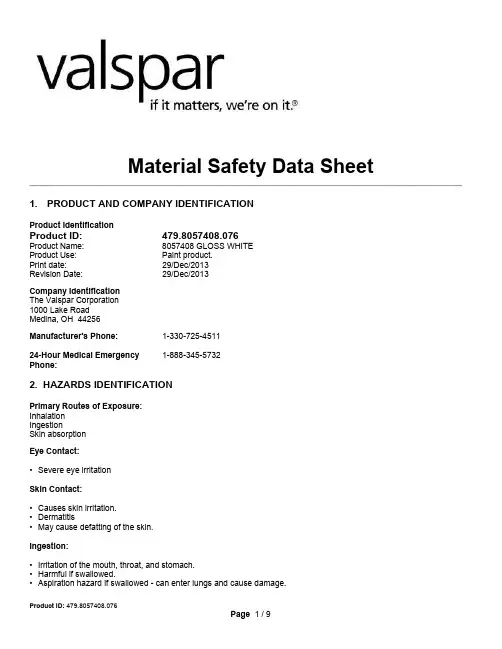
Material Safety Data Sheet________________________________________________________________________________________ 1. PRODUCT AND COMPANY IDENTIFICATIONProduct IdentificationProduct ID:479.8057408.076Product Name:8057408 GLOSS WHITEProduct Use:Paint product.Print date:29/Dec/2013Revision Date:29/Dec/2013Company IdentificationThe Valspar Corporation1000 Lake RoadMedina, OH 44256Manufacturer's Phone:1-330-725-45111-888-345-573224-Hour Medical EmergencyPhone:2. HAZARDS IDENTIFICATIONPrimary Routes of Exposure:InhalationIngestionSkin absorptionEye Contact:•Severe eye irritationSkin Contact:•Causes skin irritation.•Dermatitis•May cause defatting of the skin.Ingestion:•Irritation of the mouth, throat, and stomach.•Harmful if swallowed.•Aspiration hazard if swallowed - can enter lungs and cause damage.Inhalation:•Causes respiratory tract irritation.•Harmful by inhalation.•AsphyxiaAcute Other Health Effects:•May cause frostbite•Intentional misuse by deliberately concentrating and inhaling the contents may be harmful or fatal.Target Organ and Other Health Effects:•Causes headache, drowsiness or other effects to the central nervous system.•Liver injury may occur.•Cardiac arrhythmias•Kidney injury may occur.•Blood disordersThis product contains ingredients that may contribute to the following potential chronic health effects:•Notice: Reports have associated repeated and prolonged occupational overexposure to solvents with permanent brain and nervous system damage. Intentional misuse by deliberately concentrating and inhaling the contents may be harmful or fatal.Carcinogens:•Possible cancer hazard. Contains material which may cause cancer based on animal data.3. COMPOSITION / INFORMATION ON HAZARDOUS INGREDIENTSIngredient Name CAS-No.Approx.Weight %Chemical NameDIMETHYL KETONE-EXEMPT SOLVENT67-64-125 - 30AcetonePROPANE74-98-615 - 20PropaneBUTANE106-97-810 - 15ButaneISOBUTYL ACETATE110-19-05 - 10Isobutyl acetateMINERAL SPIRITS64742-47-85 - 10Petroleum distillates, hydrotreated lightNAPHTHA64742-89-85 - 10SOLVENT NAPHTHA, PETROLEUM, LIGHT ALIPHTITANIUM DIOXIDE13463-67-71 - 5Titanium dioxideNAPHTHA, PETROLEUM,HYDROTREATED LIGHT64742-49-01 - 5NAPHTHA, PETROLEUM, HYDROTREATED LIGHTISOPROPYL ALCOHOL67-63-01 - 5Isopropyl alcoholETHYLBENZENE100-41-4.1 - 1Ethyl benzeneIf this section is blank there are no hazardous components per OSHA guidelines.4. FIRST AID MEASURESEye Contact:In case of contact, immediately flush eyes with plenty of water for at least 15 minutes. If easy to do, remove contact lenses. If medical assistance is not immediately available, flush an additional 15 minutes. Get medical attention immediately.Skin Contact:Remove contaminated clothing and shoes. Wash off immediately with plenty of water for at least 15 minutes. Get medical attention, if symptoms develop or persist.Ingestion:Rinse mouth with water. Give one or two glasses of water. Only induce vomiting at the instruction of medical personnel. Never give anything by mouth to an unconscious person. Do NOT induce vomiting. If vomiting occurs, keep head lower than hips to prevent aspiration. Get medical attention immediately.Inhalation:Move injured person into fresh air and keep person calm under observation. Get medical attention immediately. For breathing difficulties, oxygen may be necessary. If breathing stops, provide artificial respiration. Do not give direct mouth-to-mouth resuscitation if inhaled. To protect rescuer, use air-viva, oxy-viva or one-way mask. Resuscitate in a well-ventilated area.Medical conditions aggravated by exposure:Any respiratory or skin condition.5. FIRE FIGHTING MEASURESFlash point (Fahrenheit):-31Flash point (Celsius):-35Lower explosive limit (%):1Upper explosive limit (%):13Autoignition temperature:not determinedSensitivity to impact:noSensitivity to static discharge:Subject to static discharge hazards. Please see bondingand grounding information in Section 7.Hazardous combustion products:See Section 10.Unusual fire and explosion hazards:None known.Extinguishing media:Carbon dioxide, dry chemical, foam and/or water fog.Fire fighting procedures:Firefighters should be equipped with self-contained breathing apparatus and turn out gear. Keep containers and surroundings cool with water spray.6. ACCIDENTAL RELEASE MEASURESAction to be taken if material is released or spilled:Ventilate the area. Avoid breathing dust or vapor. Use self-containing breathing apparatus or airmask for large spills in a confined area. Wipe, scrape or soak up in an inert material and put in a container for disposal. See section 7, "Handling and Storage", for proper container and storage procedures. Remove all sources of ignition. Soak up with inert absorbent material. Use only non-sparking tools. Avoid contact with eyes.7. HANDLING AND STORAGE7. HANDLING AND STORAGEPrecautions to be taken in handling and storage:Keep away from heat, sparks and open flame. - No smoking. Keep container closed when not in use. Do not store above 120 degrees F. (49 degrees C). Based on flash point and vapor pressure, suitable storage should be provided in accordance with OSHA regulation 1910.106, Ontario OH&S regulation 851 section 22. Empty containers may contain product residue, including flammable or explosive vapors. Do not cut, puncture or weld on or near container. All label warnings must be observed until the container has been commercially cleaned or reconditioned. If the product is used near or above the flashpoint, an ignition hazard may be present. Activities, uses, or operations which liberate vapor (such as mixing or free fall of liquids) may also present an ignition hazard. Please ensure containers and other interconnected equipment are properly bonded and grounded at all times.8. PERSONAL PROTECTIVE EQUIPMENT AND EXPOSURE CONTROLSPersonal Protective EquipmentEye and face protection:Wear safety glasses or goggles to protect against exposure.Skin protection:Appropriate chemical resistant gloves should be worn.Other Personel Protection Data:To prevent skin contact wear protective clothing covering all exposed areas.Respiratory protection:If exposure cannot be controlled below applicable limits, use the appropriate NIOSH approved respirator such as an air purifying respirator with organic vapor cartridge and dust/mist filter. Consult the respirator manufacturer's literature to ensure that the respirator will provide adequate protection. Read and follow all respirator manufacturer's instructions. VentilationUse only in well-ventilated areas. Ensure adequate ventilation, especially in confined areas. Ovens used for curing should contain a fresh air purge to prevent vapours from accumulating and creating a possible explosive mixture. Where the product is used in a hazardous classified area, use explosion-proof electrical/ventilating/lighting/equipment.Exposure GuidelinesOSHA Permissible Exposure Limits (PEL's)Ingredient Name CAS-No.Approx.Weight %TWA (final)Ceilings limits (final)Skin designationsDIMETHYL KETONE-EXEMPT SOLVENT 67-64-125 - 301000 ppm TWA2400 mg/m3 TWAPROPANE 74-98-615 - 201000 ppm TWA1800 mg/m3 TWAISOBUTYL ACETATE 110-19-05 - 10150 ppm TWA700 mg/m3 TWATITANIUM DIOXIDE 13463-67-71 - 515 mg/m3 TWA dusttotalISOPROPYL ALCOHOL 67-63-01 - 5400 ppm TWA980 mg/m3 TWAETHYLBENZENE 100-41-4.1 - 1100 ppm TWA435 mg/m3 TWAACGIH Threshold Limit Value (TLV's)Ingredient Name CAS-No.Approx.Weight %TWA STEL Ceiling limits SkindesignationsDIMETHYL KETONE-EXEMPT SOLVENT67-64-125 - 30500 ppm TWA750 ppm STELPROPANE 74-98-615 - 201000 ppm TWAAliphatichydrocarbon gases:Alkane C1-C4BUTANE 106-97-810 - 151000 ppm TWAAliphatichydrocarbon gases:Alkane C1-C4ISOBUTYL ACETATE110-19-05 - 10150 ppm TWATITANIUM DIOXIDE13463-67-71 - 510 mg/m3 TWAISOPROPYL ALCOHOL67-63-01 - 5200 ppm TWA400 ppm STELETHYLBENZENE100-41-4.1 - 1100 ppm TWA125 ppm STEL9. PHYSICAL PROPERTIESOdor:Normal for this product type.Physical State:AerosolpH:not determinedVapor pressure:NOT DETERMINED mmHg @ 68ºF (20ºC)Vapor density (air = 1.0): 5.1Boiling point:-44ºF (-42ºC)Solubility in water:not determinedCoefficient of water/oil distribution:not determinedDensity (lbs per US gallon): 6.16Specific Gravity:.74Evaporation rate (butyl acetate = 1.0): 5.6Flash point (Fahrenheit):-31Flash point (Celsius):-35Lower explosive limit (%):1Upper explosive limit (%):13Autoignition temperature:not determined10. STABILITY AND REACTIVITYStability:Stable under normal conditions.Conditions to Avoid:Heat.Incompatibility:Strong oxidizing agentsHazardous Polymerization:None anticipated.Hazardous Decomposition Products:Carbon monoxide and carbon dioxide.Sensitivity to static discharge:Subject to static discharge hazards. Please see bondingand grounding information in Section 7.11. TOXICOLOGICAL INFORMATION11. TOXICOLOGICAL INFORMATIONIngredient Name CAS-No.Approx.Weight %NIOSH - Selected LD50s and LC50sDIMETHYL KETONE-EXEMPT SOLVENT67-64-125 - 30= 5800 mg/kg Oral LD50 RatPROPANE74-98-615 - 20= 658 mg/L Inhalation LC50 Rat 4 hBUTANE106-97-810 - 15= 658 mg/L Inhalation LC50 Rat 4 hISOBUTYL ACETATE 110-19-05 - 10= 13400 mg/kg Oral LD50 Rat> 5000 mg/kg Dermal LD50 RabbitMINERAL SPIRITS 64742-47-85 - 10> 2000 mg/kg Dermal LD50 Rabbit> 5.2 mg/L Inhalation LC50 Rat 4 h> 5000 mg/kg Oral LD50 RatNAPHTHA 64742-89-85 - 10= 3000 mg/kg Dermal LD50 Rabbit= 5000 mg/kg Oral LD50 MouseTITANIUM DIOXIDE13463-67-71 - 5> 10000 mg/kg Oral LD50 RatNAPHTHA, PETROLEUM, HYDROTREATED LIGHT 64742-49-01 - 5= 73680 ppm Inhalation LC50 Rat 4 h> 3160 mg/kg Dermal LD50 Rabbit> 5000 mg/kg Oral LD50 RatISOPROPYL ALCOHOL 67-63-01 - 5= 12800 mg/kg Dermal LD50 Rat= 12870 mg/kg Dermal LD50 Rabbit= 4396 mg/kg Oral LD50 Rat= 72.6 mg/L Inhalation LC50 Rat 4 hETHYLBENZENE 100-41-4.1 - 1= 15354 mg/kg Dermal LD50 Rabbit= 17.2 mg/L Inhalation LC50 Rat 4 h= 3500 mg/kg Oral LD50 RatMutagens/Teratogens/Carcinogens:Possible cancer hazard. Contains material which may cause cancer based on animal data.Contains ethylbenzene, which has been determined by NTP to be an animal carcinogen with no known relevance to humans. IARC has classified ethylbenzene as possibly carcinogenic to humans (2b) on the basis of sufficient evidence of carcinogenicity in laboratory animals but inadequate evidence of cancer in humans. Contains TIO2 which is listed by IARC as a possible human carcinogen (Group 2B) based on animal data. Neither long term animal studies, nor human epidemiology studies of workers exposed to TIO2 provide an adequate basis to conclude TIO2 is carcinogenic. TIO2 is not classified as a carcinogen by NTP, U.S. OSHA, or the U.S. EPA.Ingredient Name CAS-No.Approx.Weight %California Prop 65 - Reproductive(Female)California Prop 65 - CarcinogenETHYLBENZENE 100-41-4.1 - 1Listed. initial date 6/11/04 -carcinogenIngredient Name CAS-No.Approx.Weight %IARC Group 1 - HumanEvidenceIARC Group 2A - LimitedHuman DataIARC Group 2B -Sufficient Animal DataTITANIUM DIOXIDE13463-67-71 - 5Monograph 47 [1989]ETHYLBENZENE100-41-4.1 - 1Monograph 77 [2000]Ingredient Name CAS-No.Approx.Weight %OSHA - HazardCommunicationCarcinogensOSHA - SpecificallyRegulated CarcinogensACGIH CarcinogensTITANIUM DIOXIDE13463-67-71 - 5PresentIngredient Name CAS-No.Approx.Weight %OSHA - HazardCommunicationCarcinogensOSHA - SpecificallyRegulated CarcinogensACGIH CarcinogensETHYLBENZENE 100-41-4.1 - 1Present A3 Confirmed AnimalCarcinogen withUnknown Relevance toHumans12. ECOLOGICAL DATANo information on ecology is available.13. DISPOSAL CONSIDERATIONSDisposal should be made in accordance with federal, state and local regulations.14. TRANSPORTATION INFORMATIONU.S. Department of TransportationUN ID Number (msds):CONCOMProper Shipping Name:CONSUMER COMMODITY ORM-D [Paint]U.S Hazmat and/or International DG shipment exceptionsThe supplier may apply one of the following exceptions: Combustible Liquid, Consumer Commodity, Limited Quantity, Viscous Liquid, Does Not Sustain Combustion, or others, as allowed under 49CFR Hazmat Regulations. Please consult 49CFR Subchapter C to ensure that subsequent shipments comply with these exceptions.Reportable Quantity Description:International Air Transport Association (IATA):UN/ID No:UN1950Proper shipping name:AEROSOLS, FLAMMABLEHazard Class: 2.1International Maritime Organization (IMO):UN/ID No:UN1950Proper shipping name:AEROSOLS, FLAMMABLEHazard Class: 2.1Marine Pollutant No15. REGULATORY INFORMATIONU.S. FEDERAL REGULATIONS:Ingredient Name CAS-No.Approx.Weight %SARA 302SARA 313CERCLA RQ in lbs.DIMETHYL KETONE-EXEMPT SOLVENT67-64-125 - 305000ISOBUTYL ACETATE110-19-05 - 105000ETHYLBENZENE 100-41-4.1 - 1form R reporting requiredfor 1.0% de minimisconcentration1000SARA 311/312 Hazard Class: Acute:yes Chronic:yesFlammability:yesReactivity:noSudden Pressure:yesU.S. STATE REGULATIONS:Right to Know:The specific chemical identity of a component may be withheld as a trade secret under 34 Pennsylvania Code, Chapter 317.Pennsylvania Right To Know:NAPHTHA 64742-89-8NAPHTHA, PETROLEUM, HYDROTREATED LIGHT 64742-49-0DIMETHYL KETONE- EXEMPT SOLVENT 67-64-1TITANIUM DIOXIDE 13463-67-7ISOPROPYL ALCOHOL 67-63-0ISOBUTYL ACETATE 110-19-0MINERAL SPIRITS 64742-47-8PROPANE 74-98-6BUTANE 106-97-8Additional Non-Hazardous MaterialsPROPRIETARY RESIN Trade SecretCalifornia Proposition 65:WARNING! This product contains a chemical known in the State of California to cause cancer.Rule 66 status of product Not photochemically reactive.INTERNATIONAL REGULATIONS - Chemical InventoriesUS TSCA Inventory:All components of this product are in compliance with U.S. TSCA Chemical Substance Inventory Requirements. Canada Domestic Substances List:All components of this product are listed on the Domestic Substances List.16. OTHER INFORMATIONHMIS CodesHealth:2*Flammability:4Reactivity:1PPE:X - See Section 8 for Personal Protective Equipment (PPE).Abbreviations:OSHA - Occupational Safety and Health Administration, IARC - International Agency for Research on Cancer, NIOSH -National Institute of Occupational Safety and Health, NTP - National Toxicology Program, ACGIH - American Conference of Governmental Industrial Hygienists, SCAQMD - South Coast Air Quality Management District, TSCA -Toxic Substances Control Act, IATA - International Air Transport Association, IMO - International Maritime Organization, DOT - Department of Transportation, NA - Not applicable, NOT ESTAB - Not established, N.A.V. - Not available, RQ -Reportable quantity, WT - Weight, MG/CU M - Milligrams per cubic meter, G/L - Grams per liter, MM - Millimeters, MPPCF - Millions of particles per cubic foot, PPM - parts per million, PPT - parts per thousand, TCC/PM - Tag closed cup / Pensky-Martens, PB - Lead, PEL - Permissible exposure level, TWA - Time Weighted Average, STEL - Short term exposure limit, C - Celsius, F - Fahrenheit.Disclaimer:The data on this sheet represent typical values. Since application variables are a major factor in product performance, this information should serve only as a general guide. Valspar assumes no obligation or liability for use of this information. UNLESS VALSPAR AGREES OTHERWISE IN WRITING, VALSPAR MAKES NO WARRANTIES, EXPRESS OR IMPLIED, AND DISCLAIMS ALL IMPLIED WARRANTIES INCLUDING WARRANTIES OF MERCHANTABILITY OR FITNESS FOR A PARTICULAR USE OR FREEDOM FROM PATENT INFRINGEMENT. VALSPAR WILL NOT BE LIABLE FOR ANY SPECIAL, INCIDENTAL OR CONSEQUENTIAL DAMAGES. Your only remedy for any defect in this product is the replacement of the defective product, or a refund of its purchase price, at our option. This MSDS contains additional information required by the state of Pennsylvania.Preparation Information:Prepared By:Regulatory Affairs DepartmentPrint date:29/Dec/2013Revision Date:29/Dec/2013。
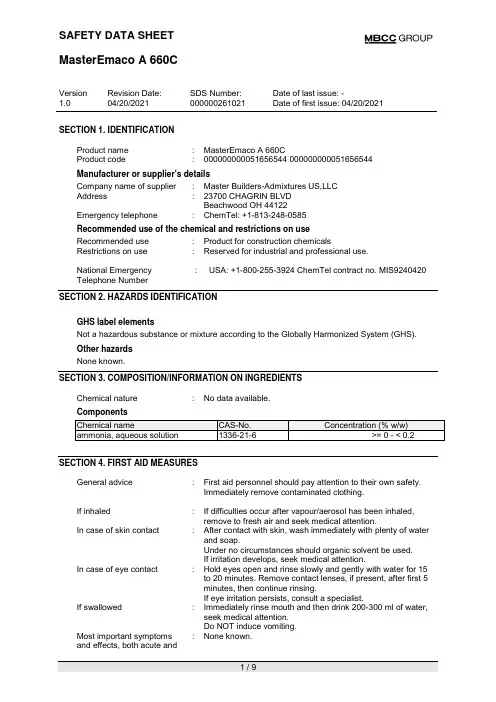
Version 1.0 Revision Date:04/20/2021SDS Number:000000261021Date of last issue: -Date of first issue: 04/20/2021SECTION 1. IDENTIFICATIONProduct name : MasterEmaco A 660CProduct code : 000000000051656544 000000000051656544Manufacturer or supplier's detailsCompany name of supplier : Master Builders-Admixtures US,LLCAddress : 23700 CHAGRIN BLVDBeachwood OH 44122Emergency telephone : ChemTel: +1-813-248-0585Recommended use of the chemical and restrictions on useRecommended use : Product for construction chemicalsRestrictions on use : Reserved for industrial and professional use.National EmergencyTelephone Number: USA: +1-800-255-3924 ChemTel contract no. MIS9240420 SECTION 2. HAZARDS IDENTIFICATIONGHS label elementsNot a hazardous substance or mixture according to the Globally Harmonized System (GHS).Other hazardsNone known.SECTION 3. COMPOSITION/INFORMATION ON INGREDIENTSChemical nature : No data available.ComponentsChemical name CAS-No. Concentration (% w/w)ammonia, aqueous solution 1336-21-6 >= 0 - < 0.2 SECTION 4. FIRST AID MEASURESGeneral advice : First aid personnel should pay attention to their own safety.Immediately remove contaminated clothing.If inhaled : If difficulties occur after vapour/aerosol has been inhaled,remove to fresh air and seek medical attention.In case of skin contact : After contact with skin, wash immediately with plenty of waterand soap.Under no circumstances should organic solvent be used.If irritation develops, seek medical attention.In case of eye contact : Hold eyes open and rinse slowly and gently with water for 15to 20 minutes. Remove contact lenses, if present, after first 5minutes, then continue rinsing.If eye irritation persists, consult a specialist.If swallowed : Immediately rinse mouth and then drink 200-300 ml of water,seek medical attention.Do NOT induce vomiting.Most important symptomsand effects, both acute and: None known.Version 1.0 Revision Date:04/20/2021SDS Number:000000261021Date of last issue: -Date of first issue: 04/20/2021delayedNotes to physician : Treat symptomatically.SECTION 5. FIRE-FIGHTING MEASURESSuitable extinguishing media : FoamWater sprayDry powderCarbon dioxide (CO2)Unsuitable extinguishingmedia: water jetSpecific hazards during firefighting: See SDS section 10 - Stability and reactivity.Hazardous combustion prod-ucts : harmful vapours nitrogen oxidesfumes/smokecarbon blackcarbon oxidesFurther information : The degree of risk is governed by the burning substance andthe fire conditions.If exposed to fire, keep containers cool by spraying with water.Collect contaminated extinguishing water separately, do notallow to reach sewage or effluent systems.Contaminated extinguishing water must be disposed of inaccordance with official regulations.Special protective equipmentfor fire-fighters: Wear a self-contained breathing apparatus.SECTION 6. ACCIDENTAL RELEASE MEASURESPersonal precautions, protec-tive equipment and emer-gency procedures : Do not breathe vapour/aerosol/spray mists.Wear eye/face protection.If exposed to high vapour concentration, leave area immedi-ately.Use personal protective clothing.Handle in accordance with good building materials hygiene and safety practice.Environmental precautions : Contain contaminated water/firefighting water.Do not discharge into drains/surface waters/groundwater.Methods and materials for containment and cleaning up : Large spills should be collected mechanically (remove by pumping) for disposal.Pick up with inert absorbent material (e.g. sand, earth etc.).Spilled product should be disposed in accordance with all applicable government regulations.SECTION 7. HANDLING AND STORAGEAdvice on safe handling : Avoid aerosol formation.Avoid inhalation of mists/vapours.Avoid skin contact.Avoid contact with eyes.Further information on stor-: Keep only in the original container in a cool, dry, well-Version 1.0 Revision Date:04/20/2021SDS Number:000000261021Date of last issue: -Date of first issue: 04/20/2021age conditions ventilated place away from ignition sources, heat or flame.Protect from direct sunlight.Materials to avoid : No applicable information available.SECTION 8. EXPOSURE CONTROLS/PERSONAL PROTECTIONIngredients with workplace control parametersComponents CAS-No. Value type(Form ofexposure) Control parame-ters / Permissible concentrationBasisammonia, aqueous solution 1336-21-6 STEL value 35 ppm ACGIHTLVTWA value 25 ppm ACGIHTLVREL value 25 ppm18 mg/m3NIOSHSTEL value 35 ppm27 mg/m3NIOSHPEL 50 ppm35 mg/m329 CFR 1910.1000 (Table Z-1)STEL value 35 ppm27 mg/m329 CFR 1910.1000 (Table Z-1-A)TWA 25 ppm(Ammonia)ACGIHSTEL 35 ppm(Ammonia)ACGIHTWA 25 ppm18 mg/m3(Ammonia)NIOSH RELST 35 ppm27 mg/m3(Ammonia)NIOSH RELEngineering measures : No applicable information available.Personal protective equipmentRespiratory protection : Wear respiratory protection if ventilation is inadequate.Wear a NIOSH-certified (or equivalent) organic va-pour/particulate respirator.Hand protectionRemarks : Wear chemical resistant protective gloves. Manufacturer'sdirections for use should be observed because of great di-versity of types.Eye protection : Safety glasses with side-shields.Skin and body protection : light protective clothingProtective measures : Do not inhale gases/vapours/aerosols.Avoid contact with the skin, eyes and clothing.Avoid exposure - obtain special instructions before use.Handle in accordance with good building materials hygieneand safety practice.Wearing of closed work clothing is recommended.Version 1.0 Revision Date:04/20/2021SDS Number:000000261021Date of last issue: -Date of first issue: 04/20/2021Hygiene measures : When using, do not eat, drink or smoke.Hands and/or face should be washed before breaks and atthe end of the shift.At the end of the shift the skin should be cleaned and skin-care agents applied.Remove contaminated clothing immediately and clean beforere-use or dispose it if necessary.Gloves must be inspected regularly and prior to each use.Replace if necessary (e.g. pinhole leaks).SECTION 9. PHYSICAL AND CHEMICAL PROPERTIESAppearance : liquidColor : whiteOdor : ammonia-like, slight odourpH : 9.5 - 10Melting point : No applicable information available.boiling temperature : No data availableFlash point : A flash point determination is unnecessary due to the highwater content.Evaporation rate : No applicable information available.Flammability (solid, gas) : not determinedUpper explosion limit / Upperflammability limit: No applicable information available.Lower explosion limit / Lowerflammability limit: No applicable information available.Vapor pressure : No data availableRelative vapor density : Heavier than air.Relative density : No applicable information available.Density : approx. 1.0 g/cm3 (68 °F / 20 °C)Bulk density : Not applicableSolubility(ies)Water solubility : solubleSolubility in other solvents : No applicable information available.Partition coefficient: n-octanol/water: Not applicableAutoignition temperature : No data availableVersion 1.0 Revision Date:04/20/2021SDS Number:000000261021Date of last issue: -Date of first issue: 04/20/2021Decomposition temperature : No decomposition if stored and handled as pre-scribed/indicated.ViscosityViscosity, dynamic : No applicable information available.Viscosity, kinematic : No applicable information available.Explosive properties : Not explosiveNot explosiveOxidizing properties : Based on its structural properties the product is not classifiedas oxidizing.Sublimation point : No applicable information available.Molecular weight : No data availableSECTION 10. STABILITY AND REACTIVITYReactivity : No hazardous reactions if stored and handled as pre-scribed/indicated.Chemical stability : The product is stable if stored and handled as pre-scribed/indicated.Possibility of hazardous reac-tions : The product is stable if stored and handled as pre-scribed/indicated.Conditions to avoid : See SDS section 7 - Handling and storage. Incompatible materials : Strong acidsStrong basesStrong oxidizing agentsStrong reducing agentsHazardous decomposition products : No hazardous decomposition products if stored and handled as prescribed/indicated.SECTION 11. TOXICOLOGICAL INFORMATIONAcute toxicityNot classified based on available information.Product:Acute oral toxicity : Remarks: No applicable information available.Acute inhalation toxicity : Remarks: No applicable information available.Acute dermal toxicity : Remarks: No applicable information available.Skin corrosion/irritationNot classified based on available information.Version 1.0 Revision Date:04/20/2021SDS Number:000000261021Date of last issue: -Date of first issue: 04/20/2021Serious eye damage/eye irritationNot classified based on available information.Respiratory or skin sensitizationSkin sensitizationNot classified based on available information.Respiratory sensitizationNot classified based on available information.Germ cell mutagenicityNot classified based on available information.CarcinogenicityNot classified based on available information.Reproductive toxicityNot classified based on available information.STOT-single exposureNot classified based on available information.STOT-repeated exposureNot classified based on available information.Aspiration toxicityNot classified based on available information.Further informationProduct:Remarks : Health injuries are not known or expected under normal use.The product has not been tested. The statements on toxicolo-gy have been derived from the properties of the individualcomponents.SECTION 12. ECOLOGICAL INFORMATIONEcotoxicityProduct:Ecotoxicology AssessmentAcute aquatic toxicity : This product has no known ecotoxicological effects.Chronic aquatic toxicity : This product has no known ecotoxicological effects.Persistence and degradabilityNo data availableBioaccumulative potentialNo data availableMobility in soilNo data availableVersion 1.0 Revision Date:04/20/2021SDS Number:000000261021Date of last issue: -Date of first issue: 04/20/2021Other adverse effects Product:Additional ecological infor-mation : Do not discharge product into the environment without control.The product has not been tested. The statements on ecotoxi-cology have been derived from the properties of the individual components.SECTION 13. DISPOSAL CONSIDERATIONSDisposal methodsWaste from residues : Dispose of in accordance with national, state and local regula-tions.Do not contaminate ponds, waterways or ditches with chemi-cal or used container.Do not discharge into drains/surface waters/groundwater.Contaminated packaging : Contaminated packaging should be emptied as far as possi-ble; then it can be passed on for recycling after being thor-oughly cleaned.Packs that cannot be cleaned should be disposed of in thesame manner as the contents.SECTION 14. TRANSPORT INFORMATIONInternational RegulationsUNRTDGNot regulated as a dangerous goodIATA-DGRNot regulated as a dangerous goodIMDG-CodeNot regulated as a dangerous goodTransport in bulk according to Annex II of MARPOL 73/78 and the IBC CodeNot applicable for product as supplied.Domestic regulation49 CFRNot regulated as a dangerous goodSECTION 15. REGULATORY INFORMATIONCalifornia Prop. 65WARNING: This product can expose you to chemicals including formaldehyde, which is/are known to the State of California to cause cancer. For more information go to.The ingredients of this product are reported in the following inventories:DSL : All components of this product are on the Canadian DSL TSCA : All chemical substances in this product are either listed asactive on the TSCA Inventory or are in compliance with aVersion 1.0 Revision Date:04/20/2021SDS Number: 000000261021Date of last issue: -Date of first issue: 04/20/2021TSCA Inventory exemption.SECTION 16. OTHER INFORMATIONFurther information NFPA 704: HMIS® IV:HMIS® ratings are based on a 0-4 rating scale, with 0 representing minimal haz-ards or risks, and 4 representing signifi-cant hazards or risks. The "*" represents a chronic hazard, while the "/" represents the absence of a chronic hazard.Full text of other abbreviations 29 CFR 1910.1000 (Table Z-1-A): OSHA - Table Z-1-A (29 CFR 1910.1000)29 CFR 1910.1000 (Table Z-1): OSHA - Table Z-1 (Limits for Air Contaminants) 29 CFR 1910.1000ACGIH : USA. ACGIH Threshold Limit Values (TLV)ACGIHTLV : American Conference of Governmental Industrial Hygienists - threshold limit values (US)NIOSH: NIOSH Pocket Guide to Chemical Hazards (US) NIOSH REL: USA. NIOSH Recommended Exposure Limits 29 CFR 1910.1000 (Table Z-1-A) / STEL value: Short Term Exposure Limit (STEL): 29 CFR 1910.1000 (Table Z-1) / PEL: Permissible exposure limit ACGIH / TWA : 8-hour, time-weighted average ACGIH / STEL: Short-term exposure limitACGIHTLV / STEL value : Short Term Exposure Limit (STEL): ACGIHTLV / TWA value : Time Weighted Average (TWA):NIOSH / REL value : Recommended exposure limit (REL): NIOSH / STEL value : Short Term Exposure Limit (STEL):NIOSH REL / TWA :Time-weighted average concentration for up to a 10-hour workday during a 40-hour workweekNIOSH REL / ST : STEL - 15-minute TWA exposure that should not be exceeded at any time during a workdayAIIC - Australian Inventory of Industrial Chemicals; ASTM - American Society for the Testing of Materials; bw - Body weight; CERCLA - Comprehensive Environmental Response, Compensa-tion, and Liability Act; CMR - Carcinogen, Mutagen or Reproductive Toxicant; DIN - Standard of1FlammabilityInstabilitySpecial hazardHealthVersion 1.0 Revision Date:04/20/2021SDS Number:000000261021Date of last issue: -Date of first issue: 04/20/2021the German Institute for Standardisation; DOT - Department of Transportation; DSL - Domestic Substances List (Canada); ECx - Concentration associated with x% response; EHS - Extremely Hazardous Substance; ELx - Loading rate associated with x% response; EmS - Emergency Schedule; ENCS - Existing and New Chemical Substances (Japan); ErCx - Concentration asso-ciated with x% growth rate response; ERG - Emergency Response Guide; GHS - Globally Har-monized System; GLP - Good Laboratory Practice; HMIS - Hazardous Materials Identification System; IARC - International Agency for Research on Cancer; IATA - International Air Transport Association; IBC - International Code for the Construction and Equipment of Ships carrying Dan-gerous Chemicals in Bulk; IC50 - Half maximal inhibitory concentration; ICAO - International Civil Aviation Organization; IECSC - Inventory of Existing Chemical Substances in China; IMDG - In-ternational Maritime Dangerous Goods; IMO - International Maritime Organization; ISHL - Indus-trial Safety and Health Law (Japan); ISO - International Organisation for Standardization; KECI - Korea Existing Chemicals Inventory; LC50 - Lethal Concentration to 50 % of a test population; LD50 - Lethal Dose to 50% of a test population (Median Lethal Dose); MARPOL - International Convention for the Prevention of Pollution from Ships; MSHA - Mine Safety and Health Admin-istration; n.o.s. - Not Otherwise Specified; NFPA - National Fire Protection Association; NO(A)EC - No Observed (Adverse) Effect Concentration; NO(A)EL - No Observed (Adverse) Effect Level; NOELR - No Observable Effect Loading Rate; NTP - National Toxicology Program; NZIoC - New Zealand Inventory of Chemicals; OECD - Organization for Economic Co-operation and Develop-ment; OPPTS - Office of Chemical Safety and Pollution Prevention; PBT - Persistent, Bioaccumu-lative and Toxic substance; PICCS - Philippines Inventory of Chemicals and Chemical Substanc-es; (Q)SAR - (Quantitative) Structure Activity Relationship; RCRA - Resource Conservation and Recovery Act; REACH - Regulation (EC) No 1907/2006 of the European Parliament and of the Council concerning the Registration, Evaluation, Authorisation and Restriction of Chemicals; RQ - Reportable Quantity; SADT - Self-Accelerating Decomposition Temperature; SARA - Superfund Amendments and Reauthorization Act; SDS - Safety Data Sheet; TCSI - Taiwan Chemical Sub-stance Inventory; TSCA - Toxic Substances Control Act (United States); UN - United Nations; UNRTDG - United Nations Recommendations on the Transport of Dangerous Goods; vPvB - Very Persistent and Very BioaccumulativeRevision Date : 04/20/2021The information provided in this Safety Data Sheet is correct to the best of our knowledge, infor-mation and belief at the date of its publication. The information given is designed only as a guid-ance for safe handling, use, processing, storage, transportation, disposal and release and is not to be considered a warranty or quality specification. The information relates only to the specific material designated and may not be valid for such material used in combination with any other materials or in any process, unless specified in the text.US / EN。
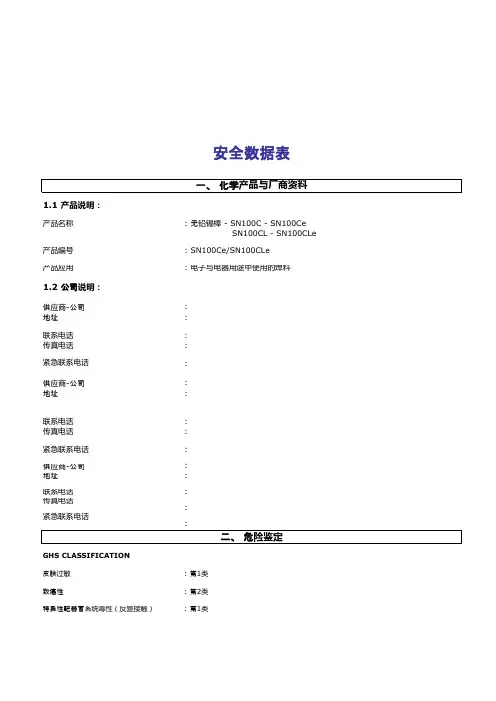
1.1 产品说明:产品名称: 无铅锡棒 - SN100C - SN100CeSN100CL - SN100CLe 产品编号: SN100Ce/SN100CLe产品应用: 电子与电器用途中使用的焊料1.2 公司说明:供应商-公司地址联系电话传真电话紧急联系电话供应商-公司地址: :: :: : :联系电话传真电话紧急联系电话供应商-公司地址: : : : :联系电话传真电话紧急联系电话: : :GHS CLASSIFICATION皮肤过敏: 第1类致癌性: 第2类特异性靶器官系统毒性(反复接触): 第1类安全数据表LABEL SYMBOL象形图含镍产品信号词: 危险危险说明: 物理危险H317 : 可能导致皮肤过敏反应H351 : 怀疑会致癌H372 : 长期或重复接触会对器官造成伤害防范说明预防: P201 : 在使用前获取特别指示P202 : 在读懂所有安全防范措施之前切勿搬动P260 : 不要吸入粉尘/烟/气体/烟雾/蒸汽/喷雾P261 : 避免吸入粉尘/烟/气体/烟雾/蒸汽/喷雾P264 : 作业后彻底清洗双手P270 : 使用本产品时不要进食、饮水或吸烟P271 : 只能在室外或通风良好之处使用P272 : 受沾染的工作服不得带出工作场地P280 : 戴防护手套/穿防护服/戴防护眼罩/戴防护面具P281 : 使用所需的个人防护设备Response: P302 + P352 : 如皮肤沾染: 用大量肥皂和水清洗P304 + P340 : 如误吸入: 将受害人转移到空气新鲜处,保持呼吸舒适的休息姿势P305 + P351 : 如进入眼睛:用水小心冲洗几分钟P308 + P313 : 如接触到或有疑虑:求医/就诊P333 + P313 : 如发生皮肤刺激或皮疹: 求医/就诊P314 : 如感觉不适,须求医/就诊P321 : 具体治疗(见本标签上的方法)P362 + P364 : 脱掉沾染的衣服,清洗后方可重新使用P363 : 沾染的衣服清洗后方可重新使用贮存防范: P402+P403 : 存放于干燥处;存放在通风良好的地方P405 : 存放处须加锁处置防范: P501 : 按照地方规章处置内装物/容器其它危险信息热焊料可灼伤眼睛和皮肤。
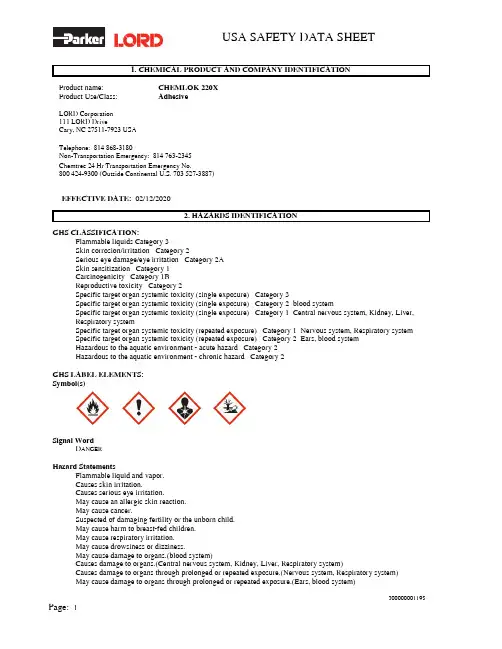
USA SAFETY DATA SHEET1. CHEMICAL PRODUCT AND COMPANY IDENTIFICATIONProduct name: CHEMLOK 220X Product Use/Class:AdhesiveLORD Corporation 111 LORD DriveCary, NC 27511-7923 USATelephone: 814 868-3180Non-Transportation Emergency: 814 763-2345 Chemtrec 24 Hr Transportation Emergency No.800 424-9300 (Outside Continental U.S. 703 527-3887)EFFECTIVE DATE: 02/12/20202. HAZARDS IDENTIFICATIONGHS CLASSIFICATION:Flammable liquids Category 3Skin corrosion/irritation Category 2Serious eye damage/eye irritation Category 2A Skin sensitization Category 1 Carcinogenicity Category 1B Reproductive toxicity Category 2Specific target organ systemic toxicity (single exposure) Category 3Specific target organ systemic toxicity (single exposure) Category 2 blood systemSpecific target organ systemic toxicity (single exposure) Category 1 Central nervous system, Kidney, Liver, Respiratory systemSpecific target organ systemic toxicity (repeated exposure) Category 1 Nervous system, Respiratory system Specific target organ systemic toxicity (repeated exposure) Category 2 Ears, blood system Hazardous to the aquatic environment - acute hazard Category 2 Hazardous to the aquatic environment - chronic hazardCategory 2GHS LABEL ELEMENTS:Symbol(s)Signal WordD ANGERHazard StatementsFlammable liquid and vapor. Causes skin irritation.Causes serious eye irritation.May cause an allergic skin reaction. May cause cancer.Suspected of damaging fertility or the unborn child. May cause harm to breast-fed children. May cause respiratory irritation. May cause drowsiness or dizziness.May cause damage to organs.(blood system)Causes damage to organs.(Central nervous system, Kidney, Liver, Respiratory system)Causes damage to organs through prolonged or repeated exposure.(Nervous system, Respiratory system) May cause damage to organs through prolonged or repeated exposure.(Ears, blood system)Toxic to aquatic life.Toxic to aquatic life with long lasting effects.Precautionary StatementsPreventionKeep away from heat/sparks/open flames/hot surfaces. - No smoking.Ground/Bond container and receiving equipment.Use explosion-proof electrical/ventilating/lighting equipment.Use only non-sparking tools.Take precautionary measures against static discharge.Obtain special instructions before use.Do not handle until all safety precautions have been read and understood.Wear protective gloves/protective clothing/eye protection/face protection.Use personal protective equipment as required.Do not breathe dust/fume/gas/mist/vapors/spray.Wash thoroughly after handling.Do not eat, drink or smoke when using this product.Use only outdoors or in a well-ventilated area.Contaminated work clothing should not be allowed out of the workplace.Avoid release to the environment.ResponseIn case of fire: refer to section 5 of SDS for extinguishing media.Call a POISON CENTER or doctor/physician if you feel unwell.IF exposed: Call a POISON CENTER or doctor/physician.Specific treatment (see supplemental first aid instructions on this label).IF INHALED: Remove to fresh air and keep at rest in a position comfortable for breathing.IF ON SKIN (or hair): Remove/Take off immediately all contaminated clothing. Rinse skin with water/shower.If skin irritation or rash occurs: Get medical advice/attention.IF IN EYES: Rinse cautiously with water for several minutes. Remove contact lenses, if present and easy to do.Continue rinsing.Collect spillage.StorageStore in a well-ventilated place. Keep cool.Store in a well-ventilated place. Keep container tightly closed.Store locked up.Disposal:Dispose of contents/container in accordance with waste/disposal laws and regulations of your country or particular locality.Other Hazards:This product contains component(s) which have the following warnings; however based on the GHS classification criteria of your country or locale, the product mixture may be outside the respective category(s).Acute: Vapor harmful; may affect the brain or nervous system causing dizziness, headache or nausea. Possibleirritation of the respiratory system can occur causing a variety of symptoms such as dryness of the throat, tightness of the chest, and shortness of breath. In elevated-temperature applications, product may release vapors that may produce cyanosis in the absence of sufficient ventilation or adequate respiratory protection. May cause central nervous system depression characterized by the following progressive steps: headache, dizziness, staggering gait, confusion,unconsciousness or coma.May be harmful if swallowed. Ingestion is not an expected route of entry in industrial or commercial uses.Chronic: May affect the gastrointestinal system. The nitrogen substituted aromatic in this product gave positiveresults for mutagenicity in an Ames Assay study while two other mutagenicity studies proved negative. Overexposure to lead in this product can damage the nervous, urinary, gastrointestinal, blood, blood-forming, and reproductivesystems. Lead and lead compounds have been classified by IARC as probable human carcinogens (Group 2A), and by NTP as reasonably anticipated human carcinogens. Ethylbenzene has been classified by IARC as a possiblehuman carcinogen (Group 2B) and reported by NTP to show clear evidence for carcinogenicity in animals. IARC has designated carbon black as Group 2B - inadequate evidence for carcinogenicity in humans, but sufficient evidence in experimental animals. In 2006 IARC reaffirmed its 1995 finding that there is "inadequate evidence" from humanconducted investigations has shown no causative link between carbon black exposure and the risk of malignant or non-malignant respiratory disease in humans. IARC and NTP have determined that there is sufficient evidence for carcinogenicity of tetrachloroethylene to experimental animals and limited evidence in humans.3. COMPOSITION/INFORMATION ON INGREDIENTSChemical Name CAS Number RangeXylene1330-20-755 - 60%Ethyl benzene100-41-410 - 15%Carbon black1333-86-4 1 - 5%Nitrogen substituted aromatic PROPRIETARY 1 - 5%Lead oxide phosphonate12141-20-7 1 - 5%Toluene108-88-30.1 - 0.9%Tetrachloroethylene127-18-40.1 - 0.9%Any "PROPRIETARY" component(s) in the above table is considered trade secret, thus the specific chemical and its exact concentration is being withheld.4. FIRST AID MEASURESFIRST AID - EYE CONTACT: Flush eyes immediately with large amount of water for at least 15 minutes holding eyelids open while flushing. Get prompt medical attention.FIRST AID - SKIN CONTACT: Flush contaminated skin with large amounts of water while removing contaminated clothing. Wash affected skin areas with soap and water. Get medical attention if symptoms occur.FIRST AID - INHALATION: Move person to fresh air. Restore and support continued breathing. If breathing is difficult, give oxygen. Get immediate medical attention.FIRST AID - INGESTION: If swallowed, do not induce vomiting. Call a physician or poison control center immediately for further instructions. Never give anything by mouth if victim is rapidly losing consciousness, unconscious or convulsing.5. FIRE-FIGHTING MEASURESSUITABLE EXTINGUISHING MEDIA: Carbon Dioxide, Dry Chemical, Foam, Water FogUNSUITABLE EXTINGUISHING MEDIA: Not determined for this product.SPECIFIC HAZARDS POSSIBLY ARISING FROM THE CHEMICAL: Flammable liquid and vapor. Keep containers tightly closed. Isolate from heat, electrical equipment, sparks, open flame, and other sources of ignition. Closed containers may rupture when exposed to extreme heat. Use water spray to keep fire exposed containers cool. During a fire, irritating and/or toxic gases and particulate may be generated by thermal decomposition or combustion.SPECIAL PROTECTIVE EQUIPMENT AND PRECAUTIONS FOR FIRE-FIGHTERS: Wear full firefighting protective clothing, including self-contained breathing apparatus (SCBA). Water spray may be ineffective. If water is used, fog nozzles are preferable.6. ACCIDENTAL RELEASE MEASURESPERSONAL PRECAUTIONS, PROTECTIVE EQUIPMENT AND EMERGENCY PROCEDURES: Remove all sources of ignition (flame, hot surfaces, and electrical, static or frictional sparks). Avoid contact. Avoid breathing vapors. Use self-contained breathing equipment.ENVIRONMENTAL PRECAUTIONS: Do not contaminate bodies of water, waterways, or ditches, with chemical or used container.METHODS AND MATERIALS FOR CONTAINMENT AND CLEANUP: Keep non-essential personnel a safe distance away from the spill area. Notify appropriate authorities if necessary. Avoid contact. Before attempting cleanup, referto hazard caution information in other sections of the SDS form. Contain and remove with inert absorbent material and non-sparking tools.7. HANDLING AND STORAGEHANDLING: Keep closure tight and container upright to prevent leakage. Ground and bond containers when transferring material. Avoid skin and eye contact. Wash thoroughly after handling. Avoid breathing of vapor or spray mists. Do not handle until all safety precautions have been read and understood. Empty containers should not be re-used. Avoid breathing sanding dust from this product. Avoid using pressurizable equipment which has aluminum or zinc parts; this product contains chlorinated solvents. Use with adequate ventilation. Because empty containers may retain product residue and flammable vapors, keep away from heat, sparks and flame; do not cut, puncture or weld on or near the empty container. This product contains inorganic lead; potential lead exposure exists when applying or sanding this product. Use of this product should comply with the OSHA Lead Standard (29 CFR 1910.1025) or where applicable the OSHA Construction Standard for lead (29 CFR 1926.62). Do not smoke where this product is used or stored.STORAGE: Do not store or use near heat, sparks, or open flame. Store only in well-ventilated areas. Do not puncture, drag, or slide container. Keep container closed when not in use. Refer to OSHA 29CFR Part 1910.106 "Flammable and Combustible Liquids" for specific storage requirements.INCOMPATIBILITY: Strong oxidizers, acids, bases, water.; Aluminum, zinc, caustics, halogens.8. EXPOSURE CONTROLS/PERSONAL PROTECTIONCOMPONENT EXPOSURE LIMITChemical Name ACGIH TLV-TWA ACGIH TLV-STELOSHA PEL-TWAOSHA PEL-CEILINGSkinXylene100 ppm150 ppm435 mg/m3100 ppmN.E.N.A.Ethyl benzene20 ppm N.E.435 mg/m3100 ppmN.E.N.A.Carbon black 3 mg/m3N.E. 3.5 mg/m3 N.E.N.A.Nitrogen substituted aromatic N.E.N.E.N.E. N.E.N.A.Lead oxide phosphonate0.05 mg/m3N.E.0.05 mg/m3 N.E.N.A.Toluene20 ppm N.E.200 ppm 300 ppmN.A.Tetrachloroethylene25 ppm100 ppm100 ppm 100 ppmN.A.N.A. - Not Applicable, N.E. - Not Established, S - Skin DesignationEngineering controls: Sufficient ventilation in pattern and volume should be provided in order to maintain air contaminant levels below recommended exposure limits. Caution: Solvent vapors are heavier than air and collect in lower levels of the work area. Sufficient ventilation (using explosion-proof equipment) should be provided to prevent flammable vapor/air mixtures from accumulating.PERSONAL PROTECTION MEASURES/EQUIPMENT:RESPIRATORY PROTECTION: Use a NIOSH approved chemical/mechanical filter respirator designed to remove a combination of particulates and organic vapor if occupational limits are exceeded. For emergencysituations, confined space use, or other conditions where exposure limits may be greatly exceeded, use an approved air-supplied respirator. For respirator use observe OSHA regulations (29CFR 1910.134) or use in accordance with applicable laws and regulations of your country or particular locality.SKIN PROTECTION: Use neoprene, nitrile, or rubber gloves to prevent skin contact.EYE PROTECTION: Use safety eyewear including safety glasses with side shields and chemical goggles where splashing may occur.OTHER PROTECTIVE EQUIPMENT: Use disposable or impervious clothing if work clothing contamination is likely. Remove and wash contaminated clothing before reuse.HYGIENIC PRACTICES: Wash hands before eating, smoking, or using toilet facility. Do not smoke in anychemical handling or storage area. Food or beverages should not be consumed anywhere this product is handled or stored. Wash thoroughly after handling.9. PHYSICAL AND CHEMICAL PROPERTIESTypical values, not to be used for specification purposes.ODOR: Solvent VAPOR PRESSURE: N.D.APPEARANCE: Black VAPOR DENSITY: Heavier than Air PHYSICAL STATE: Liquid LOWER EXPLOSIVE LIMIT: 1 %(V)UPPER EXPLOSIVE LIMIT: 7 %(V)FLASH POINT: 81 °F, 27 °C SetaflashClosed CupBOILING RANGE: 136 - 141 °C EVAPORATION RATE: Slower than n-butyl-acetate AUTOIGNITION TEMPERATURE:N.D.DENSITY: 0.98 g/cm3 - 8.15 lb/gal DECOMPOSITION TEMPERATURE:N.D. VISCOSITY, DYNAMIC: ≥80 mPa.s @ 25 °C ODOR THRESHOLD: N.D.VISCOSITY, KINEMATIC: ≥82 mm2/s @ 25 °CSOLUBILITY IN H2O: Insoluble VOLATILE BY WEIGHT: 75.21 %pH: N.A.VOLATILE BY VOLUME: 85.70 %FREEZE POINT: N.D. VOC CALCULATED: 6.02 lb/gal, 722 g/lN.D.COEFFICIENT OF WATER/OILDISTRIBUTION:LEGEND: N.A. - Not Applicable, N.E. - Not Established, N.D. - Not Determined10. STABILITY AND REACTIVITYHAZARDOUS POLYMERIZATION: Hazardous polymerization will not occur under normal conditions. STABILITY: Product is stable under normal storage conditions.CONDITIONS TO AVOID: High temperatures. Sources of ignition.; Aluminum or galvanized parts in a closed system. INCOMPATIBILITY: Strong oxidizers, acids, bases, water.; Aluminum, zinc, caustics, halogens.HAZARDOUS DECOMPOSITION PRODUCTS: Carbon dioxide, carbon monoxide, chlorine, hydrogen chloride, Phosgene, Lead fume, Oxides of nitrogen11. TOXICOLOGICAL INFORMATIONEXPOSURE PATH: Refer to section 2 of this SDS.SYMPTOMS:Refer to section 2 of this SDS.TOXICITY MEASURES:Chemical Name LD50/LC50Xylene Oral LD50: Rat3,500 mg/kgDermal LD50: Rabbit> 4,350 mg/kgInhalation LC50: Rat29.08 mg/l/4 hEthyl benzene Oral LD50: Rat3,500 mg/kgDermal LD50: Rabbit15,400 mg/kgInhalation LC50: Rat17.4 mg/l/4 hCarbon black Oral LD50: Rat> 15,400 mg/kgDermal LD50: Rabbit> 3 g/kgGHS LC50 (vapour): Acute toxicity point estimate55 mg/lNitrogen substituted aromatic Oral LD50: rat1,100 mg/kgLead oxide phosphonate GHS LC50 (vapour): Acute toxicity point estimate55 mg/lDermal LD50: Rabbit12,000 mg/kgInhalation LC50: Rat12.5 mg/l/4 hTetrachloroethylene Oral LD50: Rat2,629 mg/kgInhalation LC50: Rat27.8 mg/l/4 hGerm cell mutagenicity: No classification proposedCarcinogenicity: Category 1B - May cause cancer.Components contributing to classification: Ethyl benzene. Lead oxide phosphonate. Tetrachloroethylene.Reproductive toxicity: Category 2 - Suspected of damaging fertility or the unborn child. May cause harm to breast-fed children.Components contributing to classification: Xylene. Ethyl benzene. Lead oxide phosphonate. Toluene.Tetrachloroethylene.12. ECOLOGICAL INFORMATIONECOTOXICITY:Chemical Name EcotoxicityXylene Fish: Pimephales promelas13.4 mg/l96 h flow-throughOncorhynchus mykiss2.661 - 4.093 mg/l96 h StaticOncorhynchus mykiss13.5 - 17.3 mg/l96 hLepomis macrochirus13.1 - 16.5 mg/l96 h flow-throughLepomis macrochirus19 mg/l96 hLepomis macrochirus7.711 - 9.591 mg/l96 h StaticPimephales promelas23.53 - 29.97 mg/l96 h StaticCyprinus carpio780 mg/l96 h semi-staticCyprinus carpio> 780 mg/l96 hPoecilia reticulata30.26 - 40.75 mg/l96 h StaticInvertebrates: water flea3.82 mg/l48 hGammarus lacustris0.6 mg/l48 hEthyl benzene Fish: Oncorhynchus mykiss11.0 - 18.0 mg/l96 h StaticOncorhynchus mykiss4.2 mg/l96 h semi-staticPimephales promelas7.55 - 11 mg/l96 h flow-throughLepomis macrochirus32 mg/l96 h StaticPimephales promelas9.1 - 15.6 mg/l96 h StaticPoecilia reticulata9.6 mg/l96 h StaticInvertebrates: Daphnia magna1.8 - 2.4 mg/l48 hPlants: Pseudokirchneriella subcapitata4.6 mg/l72 hPseudokirchneriella subcapitata> 438 mg/l96 hPseudokirchneriella subcapitata2.6 - 11.3 mg/l72 h StaticPseudokirchneriella subcapitata1.7 - 7.6 mg/l96 h StaticCarbon black N.D.Nitrogen substituted aromatic N.D.Lead oxide phosphonate N.D.Toluene Fish: Pimephales promelas15.22 - 19.05 mg/l96 h flow-throughPimephales promelas12.6 mg/l96 h StaticOncorhynchus mykiss5.89 - 7.81 mg/l96 h flow-throughOncorhynchus mykiss14.1 - 17.16 mg/l96 h StaticOncorhynchus mykiss5.8 mg/l96 h semi-staticLepomis macrochirus11.0 - 15.0 mg/l96 h StaticOryzias latipes54 mg/l96 h StaticPoecilia reticulata28.2 mg/l96 h semi-staticPoecilia reticulata50.87 - 70.34 mg/l96 h StaticInvertebrates: Daphnia magna5.46 - 9.83 mg/l48 h StaticDaphnia magna11.5 mg/l48 hPlants: Pseudokirchneriella subcapitata> 433 mg/l96 hPseudokirchneriella subcapitata12.5 mg/l72 h StaticTetrachloroethylene Fish: Pimephales promelas12.4 - 14.4 mg/l96 h flow-throughPimephales promelas8.6 - 13.5 mg/l96 h StaticLepomis macrochirus11.0 - 15.0 mg/l96 h StaticOncorhynchus mykiss4.73 - 5.27 mg/l96 h flow-throughInvertebrates: Daphnia magna6.1 - 9.0 mg/l48 h StaticPlants: Pseudokirchneriella subcapitata> 500 mg/l96 hPERSISTENCE AND DEGRADABILITY:Not determined for this product.BIOACCUMULATIVE: Not determined for this product.MOBILITY IN SOIL: Not determined for this product.OTHER ADVERSE EFFECTS: Not determined for this product.13. DISPOSAL CONSIDERATIONSDISPOSAL METHOD: Disposal should be done in accordance with Federal (40CFR Part 261), state and local environmental control regulations. If waste is determined to be hazardous, use licensed hazardous waste transporter and disposal facility.14. TRANSPORT INFORMATIONUS DOT RoadProper Shipping Name: AdhesivesHazard Class: 3SECONDARY HAZARD: NoneUN/NA Number: 1133Packing Group: IIIEmergency Response Guide Number: 128IATA CargoPROPER SHIPPING NAME: AdhesivesHazard Class: 3HAZARD CLASS: NoneUN NUMBER: 1133PACKING GROUP: IIIEMS: 3LIMDGPROPER SHIPPING NAME: AdhesivesHazard Class: 3HAZARD CLASS: NoneUN NUMBER: 1133PACKING GROUP: IIIEMS: F-EThe listed transportation classification applies to non-bulk shipments. It does not address regulatory variations due to changes in package size, mode of shipment or other regulatory descriptors. For the most accurate shipping information, refer to your transportation/compliance department.15. REGULATORY INFORMATIONU.S. FEDERAL REGULATIONS: AS FOLLOWS:SARA SECTION 313This product contains the following substances subject to the reporting requirements of Section 313 of Title III of the Superfund Amendment and Reauthorization Act of 1986 and 40 CFR part 372.:Chemical Name CAS Number Weight % Less ThanXylene1330-20-760.0%Ethyl benzene100-41-415.0%Lead oxide phosphonate12141-20-7 5.0%Toluene108-88-30.9%Tetrachloroethylene127-18-40.9%TOXIC SUBSTANCES CONTROL ACT:INVENTORY STATUSThe chemical substances in this product are on the TSCA Section 8 Inventory.EXPORT NOTIFICATIONThis product contains the following chemical substances subject to the reporting requirements of TSCA 12(B) if exported from the United States:None16. OTHER INFORMATIONUnder HazCom 2012 it is optional to continue using the HMIS rating system. It is important to ensure employees have been trained to recognize the different numeric ratings associated with the HazCom 2012 and HMIS schemes.HMIS RATINGS - HEALTH: 2* FLAMMABILITY: 3 PHYSICAL HAZARD: 0* - Indicates a chronic hazard; see Section 2Revision: Section 2, Section 3, Section 8, Section 11, Section 12Effective Date: 02/12/2020DISCLAIMERThe information contained herein is, to the best of our knowledge and belief, accurate. However, since the conditions of handling and use are beyond our control, we make no guarantee of results, and assume no liability for damages incurred by use of this material. It is the responsibility of the user to comply with all applicable federal, state and local laws and regulations.。
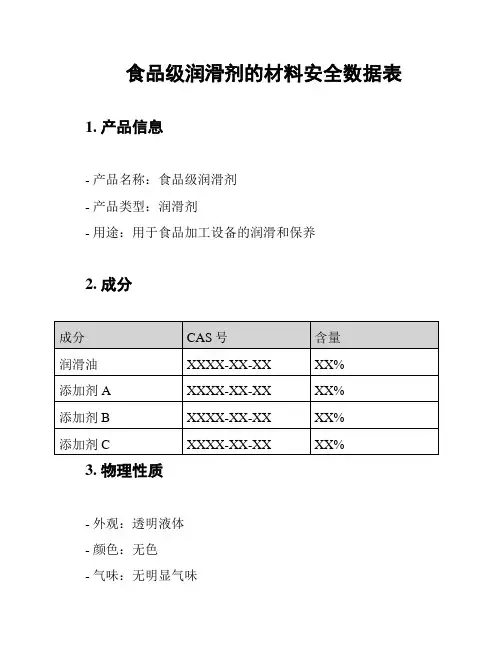
食品级润滑剂的材料安全数据表1. 产品信息
- 产品名称:食品级润滑剂
- 产品类型:润滑剂
- 用途:用于食品加工设备的润滑和保养
2. 成分
3. 物理性质
- 外观:透明液体
- 颜色:无色
- 气味:无明显气味
- 相对密度:X g/cm³
- 熔点:X°C
- 沸点:X°C
- 燃烧性:不易燃烧
- 溶解性:可溶于X溶剂
4. 安全性评估
- 急性毒性:本产品经急性毒性测试,未发现对人体有明显毒害作用。
- 过敏性:本产品经过过敏原测试,未发现过敏原成分。
- 致癌性:本产品未包含任何已知的致癌物质。
- 环境影响:本产品对环境无明显毒性,但应避免直接排放到水体或土壤中。
5. 使用和储存注意事项
- 使用时请遵循操作规程和安全操作指南。
- 存放于阴凉、干燥、通风良好的地方。
- 避免与氧化剂、强酸、强碱等物质接触。
6. 应急措施
- 皮肤接触:立即用大量清水冲洗受影响部位,如有不适请就医。
- 眼睛接触:立即用大量清水冲洗眼睛,如有不适请就医。
- 吸入:迅速将患者移至空气新鲜处,如有呼吸困难请就医。
- 吞食:不要催吐,立即就医。
7. 废弃物处理
- 废弃物需按照当地法规进行处理,不得随意倾倒。
请注意:本文档提供的信息仅供参考,使用者在使用产品前应仔细阅读产品标签上的使用说明,并遵循相关安全操作规程。
聚乙烯 PE 材料安全数据表1. 产品识别
- 产品名称:聚乙烯 (PE) 材料
- 产品类型:聚合物
- 化学名称:聚乙烯
- CAS 号:9002-88-4
2. 成分信息
- 主要成分:聚乙烯
- 化学结构:无定型结构
- 分子式:(C2H4)n
3. 物理性质
- 外观:无色固体
- 溶解性:不溶于水,不溶于大多数有机溶剂
- 比重:0.91-0.97 g/cm³
- 熔点:105-130°C
- 燃点:自燃温度高,不易燃烧
4. 健康和安全信息
- 呼吸系统:长期接触高浓度的粉尘可能引起呼吸道刺激
- 皮肤接触:无刺激性,但长时间接触可能引起轻微刺激
- 眼睛接触:可能引起眼睛刺激,但不会造成永久损伤
- 摄入:不适用于摄入
5. 环境影响
- 生态毒性:聚乙烯是一种环境友好的材料,对环境无毒害
6. 应急措施
- 眼睛接触:立即用大量清水冲洗至少15分钟,如有不适,立即就医
- 皮肤接触:立即用清水和肥皂冲洗,如有不适,寻求医疗帮助
- 吸入:将患者移至新鲜空气,如有呼吸困难,立即就医
- 意外摄入:不适用于摄入,如意外摄入,立即就医
7. 存储和处理
- 存储:储存在干燥、通风良好的地方,避免阳光直射
- 处理:按照当地法规处理废弃物,不得随意丢弃
8. 法规信息
- 聚乙烯 (PE) 材料符合国家和国际相关安全和环境法规的要求
请注意:以上信息仅供参考,准确性有限。
在使用聚乙烯材料前,请查阅具体的安全数据表和法规要求,以确保安全使用和处理。
产品安全数据表作成日2014年09月02日改定日2014年11月07日1.化学品及企业标识商品名:新明丹SP-RED (SHINMYOTAN SP-RED)企业名称:株式会社ナカタニ地址:东京文京区汤岛3-9-3相关部门:产业机器部作成者:柳泽洋电话号码:03-3833-1601传真号码: 03-3833-1578邮件地址:yanagisawa@nakatani-grp.co.jp应急电话:03-3833-1601推荐用途使用上的限制:模具边角检查及加工件啮合检查剂整理号: C-3010022.危害性概述GHS分类物理化学性危害火药类分类对象外可燃性・引燃性气体分类对象外可燃性喷雾剂分类对象外助燃性・氧化性气体分类对象外高压气体分类对象外引燃性液体分类对象外可燃性固体区分外自我反应性化学品分类对象外自然起火性液体分类对象外自然起火性固体区分外自然起火性化学品区分外水合反应可燃性液体分类对象外氧化性液体分类对象外氧化性固体区分外有机过氧化物分类对象外腐蚀金属性物质无法分类人健康有害性急性毒性(经口)区分外急性毒性(经皮肤)无法分类急性毒性(吸入:气体)分类对象外急性毒性(吸入:蒸汽)无法分类急性毒性(吸入:粉尘)区分外急性毒性(吸入:喷雾)分类对象外腐蚀皮肤性・刺激性无法分类对眼睛造成的严重损伤・对眼睛的刺激性无法分类呼吸器致敏性无法分类皮肤致敏性无法分类生殖细胞变异原性无法分类致癌性无法分类特定目标器官·全身毒性区分1(肺,全身毒性)(单次暴露)特定目标器官·全身毒性无法分类(反复暴露)吸引性呼吸器有害性无法分类环境危害水生环境急性有害性区分外水生环境慢性有害性区分外对臭氧层的有害性无法分类标签构成警示语:危险危害性信息:有对生育机能及对胎儿产生不良影响的可能性对脏器的损害(肺,全身毒性)注意事项:【安全对策】使用前要取得使用说明书在没有完全理解安全注意前,不可使用不吸入粉尘使用此商品时,不可吃东西或吸烟需配带保护手套,护眼镜,面罩【急救措施】回收泄漏物接触或有接触到的可能性时:及时联络医生就诊,获得诊断/治疗【保存】上锁封存【废弃】委托给政府机关颁发许可的专业废弃物处理机构其他情报使用后需密封避免阳光直射,存放于通风阴凉处国家/地区信息:3.组成·成分信息单一产品混合物的区分:混合物成分名化学成含有量(%) CAS号码官报公示整理号码氧化锌ZnO 35~45 1314-13-2 (1)-561矿物油无法确定30~40 非公开二羟基硬脂酸铝C18H37ALO45~15 7047-84-9颜料橙16 C34H32N6O65~15 6505-28-8聚氧乙烯聚氧丙烯一丁基醚C4H10O(C3H6OC2H4O)x3~10 9038-95-3 (7)-97偶氮色淀C H CIN O SBa 1~2 7585-41-3 (5)-32334.紧急措施吸入时:移至通风处,擤鼻涕,漱口。
HAVILAND PRODUCTS COMPANYSAFETY DATA SHEETSection 1: IdentificationProduct Name: Havaclean Hand Sanitizer-E Product Code:H006616Haviland Products Company 421 Ann Street NWGrand Rapids, MI 49504 (616) 361-6691Emergency Phone:CHEMTREC: Canada and USA - (800) 424-9300 CHEMTREC:In Mexico - 01-800-681-9531Product Use: Hand SanitizerNot recommended for: NASection 2: Hazard(s) IdentificationGHS Ratings:Flammable liquid2Skin corrosive3Eye corrosive2BOrgan toxin single exposure3Organ toxin repeated exposure 1Flash point < 23°C and initial boiling point > 35°C (95°F)Reversible adverse effects in dermal tissue, Draize score: >=1.5 <2.3Mild eye irritant: Subcategory 2B, Reversible in 7 daysTransient target organ effects- Narcotic effects- Respiratorytract irritationSignificant toxicity in humans- Reliable, good quality humancase studies or epidemiological studies Presumedsignificant toxicity in humans- Animal studies with significantand/or severe toxic effects relevant to humans at generallylow exposure (guidanc e)GHS HazardsH225Highly flammable liquid and vapour H316Causes mild skin irritationH320Causes eye irritationH335May cause respiratory irritationH336May cause drowsiness ordizzinessH372Causes damage to organsthrough prolonged or repeatedexposure GHS PrecautionsP210Keep away from heat/sparks/openflames/hot surfaces – No smokingP233Keep container tightly closedP240Ground/bond container and receivingequipmentP241Use explosion-proofelectrical/ventilating/light/equipmentP242Use only non-sparking toolsP243Take precautionary measures againststatic dischargeP260Do not breathedust/fume/gas/mist/vapors/sprayP261Avoid breathingdust/fume/gas/mist/vapors/sprayP264Wash face, hands, and any exposedskin thoroughly after handlingP270Do not eat, drink or smoke when usingthis productP271Use only outdoors or in a well-ventilatedareaPowered by Plymouth Technolog yP280Wear protective gloves/protective clothing/eye protection/face protection P312Call a POISON CENTER ordoctor/physician if you feel unwellP314Get Medical advice/attention if you feel unwellP303+P361+P353If on skin (or hair): Remove / Take off immediately all contaminated clothing. Rinse skin with water / shower.P304+P340If inhales: Remove victim to fresh air and keep at rest in a position comfortable for breathing.P305+P351+P338If in eyes: Rinse cautiously with water for several minutes. Remove contact lenses, if present and easy to do. Continue rinsing.P332+P313If skin irritation occurs: Get medical advice / attentionP337+P313If eye irritation persists get medical advice / attentionP370+P378In case of fire: Use suitable media for extinctionP405Store locked upP403+P233Store in a well-ventilated place. Keep container tightly closed.P403+P235Store in a well ventilated place. Keep coolP501Dispose of contents/container in accordance withlocal/regional/national/international regulationsDangerSection 3: Composition/Information on IngredientsChemical Name / CAS No.OSHA Exposure Limits ACGIH Exposure Limits Other Exposure LimitsEthyl alcohol 64-17-570% - 80%Vapor Pressure: 42.979 mmHg1000 ppm TWA; 1900 mg/m3 TWA1000 ppm STELNIOSH: 1000 ppmTWA; 1900 mg/m3 TWAGlycerin 56-81-51% - 5%Vapor Pressure: .002 mmHg15 mg/m3 TWA (mist, total particulate); 5 mg/m3 TWA (mist, respirable fraction)Hydrogen peroxide 7722-84-10.1% - 1.0%1 ppm TWA; 1.4 mg/m3 TWA1 ppm TWANIOSH: 1 ppm TWA; 1.4 mg/m3 TWASection 4: First-aid MeasuresInhalationRescuers should put on appropriate protective gear. Remove from area of exposure. If not breathing,give artificial respiration. If breathing is difficult, give oxygen. Keep victim warm. Get immediate medical attention. Toprevent aspiration, keep head below knees.Eye ContactImmediately flush eyes with water. Flush eyes with water for a minimum of 15 minutes, occasionallylifting and lowering upper lids. Get medical attention promptly.Skin ContactRemove contaminated clothing. Wash skin with soap and water. Get medical attention. Wash clothingseparately and clean shoes before reuse.IngestionIf swallowed, do NOT induce vomiting. Give victim a glass of water. Call a physician or poison control centerimmediately. Never give anything by mouth to an unconscious person.Section 5: Fire-fighting MeasuresExtinguishing MediaWater spray. Alcohol-resistant foam. BC powder. Carbon dioxide.Do not use: Solid water jet ineffective as extinguishing medium.Specific Hazards Arising from the ChemicalDIRECT FIRE HAZARD. Highly flammable. Gas/vapour flammable with air within explosion limits.INDIRECT FIRE HAZARD. May be ignited by sparks. Gas/vapour spreads at floor level:ignition hazard. Reactions involving a fire hazard: see "Reactivity Hazard".Explosion hazard : DIRECT EXPLOSION HAZARD. Gas/vapour explosive with air within explosion limits.INDIRECT EXPLOSION HAZARD. may be ignited by sparks. Reactions with explosion hazards:see "Reactivity Hazard".Special Protective Equipment and Precautions for FirefightersSpecial Information: As in any fire, wear self-contained breathing apparatus pressure-demand (MSHA / NIOSHapproved or equivalent) and full protective gear.Section 6: Accidental Release MeasuresSpill and Leak ProceduresRemove ignition sources. Use special care to avoid static electric charges. No naked lights. Nosmoking.Keep upwind. Mark the danger area. Consider evacuation. Seal off low-lying areas.Close doors and windows of adjacent premises. Stop engines and no smoking. No naked flamesor sparks.Spark- and explosion-proof appliances and lighting equipment. Keep containersclosed. Wash contaminated clothes.Clean up methods:Take up liquid spill into a non combustible material e .g.: sand, earth, vermiculite or powderedlimestone. Scoop absorbed substance into closing containers. See "Material-handling"forsuitable container materials. Carefully collect the spill/leftovers. Damaged/cooled tanks must beemptied. Do not use compressed air for pumping over spills. Clean contaminated surfaces withan excess of water. Take collected spill to manufacturer/competent authority . Wash clothing andequipment after handling.Section 7: Handling and StoragePrinted: 4/6/2020 at 2:51:41PMHandling ProceduresProper grounding procedures to avoid static electricity should be followed. Ground/bond container and receiving equipment. Use explosion-proofelectrical/ventilating/lighting/equipment.Use with adequate ventilation. Avoid breathing dusts, mists, and vapors. Do not get in eyes, on skin, or on clothing. Wear eye protection and protective clothing . Wash thoroughly after handling.Storage RequirementsKeep container tightly closed. Keep only in the original container in a cool, well ventilated place away from : incompatible materials. Keep in fireproof place.Incompatible products : Strong bases. Strong acids.Incompatible materials : Sources of ignition. Direct sunlight. Heat sources.Heat and ignition sources : KEEP SUBSTANCE AWAY FROM: heat sources. ignition sources.Prohibitions on mixed storage : KEEP SUBSTANCE AWAY FROM: oxidizing agents. (strong) acids. water/moisture.Storage area : Keep out of direct sunlight. Store in a dry area. Ventilation at floor level. Fireproof storeroom.Provide for an automatic sprinkler system. Provide for a tub to collect spills. Provide the tank with earthing. Meet the legal requirements.Special rules on packaging : SPECIAL REQUIREMENTS: closing. dry. clean. correctly labelled. meet the legal requirements.Secure fragile packagings in solid containers.Packaging materials : SUITABLE MATERIAL: stainless steel. aluminium. iron. copper. nickel. synthetic material. glass.Section 8: Exposure Control/Personal ProtectionOther Exposure LimitsACGIH Exposure Limits OSHA Exposure Limits Chemical Name / CAS No.1000 ppm TWA; 1900 mg/m3 TWA1000 ppm STELNIOSH: 1000 ppm TWA; 1900 mg/m3 TWAEthyl alcohol 64-17-515 mg/m3 TWA (mist, total particulate); 5 mg/m3 TWA (mist, respirable fraction)Glycerin 56-81-51 ppm TWA; 1.4 mg/m3 TWA1 ppm TWANIOSH: 1 ppm TWA; 1.4 mg/m3 TWAHydrogen peroxide 7722-84-1ENGINEERING CONTROLS: Provide ventilation sufficient to maintain exposure below the recommended limits.RESPIRATORY PROTECTION: A respiratory protection program that meets OSHA 1910.134 and ANSI Z88.2 requirements must be followed whenever workplace conditions warrant the use of a respirator.SKIN PROTECTION: Wear impervious protective gloves. Wear protective gear as needed - apron, suit, boots. EYE PROTECTION: Wear safety glasses with side shields (or goggles) and a face shield.OTHER PROTECTIVE EQUIPMENT : Facilities storing or utilizing this material should be equipped with an eyewash facility and a safety shower.HYGENIC PRACTICES: Do not eat, drink, or smoke in areas where this material is used. Avoid breathing vapors. Remove contaminated clothing and wash before reuse. Wash thoroughly after handling. Wash hands before eating.Section 9: Physical and Chemical PropertiesClear Colorless Liquid Appearance:AlcoholOdor:Not Available Vapor Pressure:Not AvailableOdor threshold:1.6Vapor Density: 6.5 - 8.5pH:Not AvailableDensity:Not AvailableMelting point:Not Available Freezing point:Complete Solubility:70° CBoiling range:25° C Flash point:8.3Evaporation rate (Ether=1):Not Available Flammability:Not AvailableExplosive Limits:0.837Specific Gravity Not AvailableAutoignition temperature:Not AvailableDecomposition temperature:Not Available Viscosity:Not AvailableGrams VOC less water:Section 10: Stability and Reactivity Chemical Stability:STABLEIncompatible MaterialsStrong acids. Strong bases.Conditions to AvoidDirect sunlight. Extremely high or low temperatures. Open flame.Hazardous Decomposition ProductsFume. Carbon monoxide. Carbon dioxide. May release flammable gases.Hazardous PolymerizationHazardous polymerization will not occur.Section 11: Toxicology InformationMixture ToxicityInhalation Toxicity LC50: 150mg/L Component Toxicity7722-84-1Hydrogen peroxideOral LD50: 801 mg/kg (Rat) Dermal LD50: 4,060 mg/kg (Rat) Inhalation LC50: 2 g/m3 (Rat)Routes of Entry:Inhalation Ingestion Skin contact Eye contactTarget OrgansBlood Eyes KidneysLiver Central Nervous System Reproductive System SkinRespiratory System Effects of OverexposureCarcinogen Rating CAS Number Description% Weight Hydrogen peroxide:7722-84-1Hydrogen peroxide 0.1% - 1.0%Section 12: Ecological InformationComponent Ecotoxicity Ethyl alcohol96 Hr LC50 Oncorhynchus mykiss: 12.0 - 16.0 mL/L [static]; 96 Hr LC50Pimephales promelas: >100 mg/L [static]; 96 Hr LC50 Pimephales promelas: 13400 - 15100 mg/L [flow-through]48 Hr LC50 Daphnia magna: 9268 - 14221 mg/L; 48 Hr EC50 Daphnia magna: 2 mg/L [Static]Glycerin96 Hr LC50 Oncorhynchus mykiss: 51 - 57 mL/L [static]Hydrogen peroxide96 Hr LC50 Pimephales promelas: 16.4 mg/L; 96 Hr LC50 Lepomis macrochirus:18 - 56 mg/L [static]; 96 Hr LC50 Oncorhynchus mykiss: 10.0 - 32.0 mg/L [static]48 Hr EC50 Daphnia magna: 18 - 32 mg/L [Static]Section 13: Disposal ConsiderationsDispose of in accordance with local, state and federal regulations.Section 14: Transportation InformationUN Code: 1993Proper Shipping Name: Flammable liquid, N.O.S. (Ethanol)Hazard Class: 3Packing Group: IIISection 15: Regulatory InformationOSHA Process Safety Management Highly Hazardous Chemicals7722-84-1 Hydrogen peroxideTSCA 8(b) Inventory7722-84-1 Hydrogen peroxide56-81-5 Glycerin64-17-5 Ethyl alcoholRegulationCountryAll Components ListedSection 16: Other InformationDate Prepared: 4/6/2020DisclaimerThe information herein is believed to be correct, but does not claim to be all inclusive and should beused only as a guide. Neither the above named supplier nor any of its affiliates or subsidiaries assumesany liability whatsoever for the accuracy or completeness of the information contained herein. Finaldetermination of suitability of any material is the sole responsibility of the user. All chemical reagentsmust be handled with the recognition that their chemical, physiological, toxicological, and hazardousproperties have not been fully investigated or determined. All chemical reagents should be handledonly by individuals who are familiar with their potential hazards and who have been fully trained in propersafety, laboratory, and chemical handling procedures. Although certain hazards are described herein,we can not guarantee that these are the only hazards which exist. Our SDS are based only on dataavailable at the time of shipping and are subject to change without notice as new information is obtained.Avoid long storage periods since the product is subject to degradation with age and may become moredangerous or hazardous. It is the responsibility of the user to request updated SDS for products that arestored for extended periods. Disposal of unused product must be undertaken by qualified personnelwho are knowledgeable in all applicable regulations and follow all pertinent safety precautions includingthe use of appropriate protective equipment (e.g. protective goggles, protective clothing, breathingequipment, face mask, fume hood). For proper handling and disposal, always comply with federal, stateand local regulations.。
有机硅胶物质安全数据表(MSDS)1、化学品和公司标识供应商名称:产品名称:OPT5569T有机硅胶产品类型:有机硅胶公司地址:电话:网址:2、产品成分信息成分 CAS 含量(%)甲基乙烯基硅氧烷 68083-19-2 50%-70%二甲基硅油 63148-62-9 5%-15%甲基氢硅氧烷 70131-67-8 5%-30%硅微粉 14464-46-1 10%-30%3、危险性概述危险性分类:非危险化学品进入人体途径:皮肤、眼睛接触可能产生症状:皮肤及眼睛不适皮肤接触:可能对皮肤有轻微刺激眼接触:含对眼睛刺激性物质,可能导致视觉模糊、灼痛和流泪吸入:蒸汽可能导致呼吸道刺激吞入:吞入本品有害就业禁忌:现患皮肤和肺的过敏性疾病者接触本品易诱发过敏反应。
4、急救措施眼睛接触:撑开眼皮,用水彻底冲洗 15 分钟以上,必要时就医。
皮肤接触:脱去粘连衣物,用布或纸擦净沾染物,用水彻底冲洗基础皮肤部位,再用肥皂水清洗,必要时就医。
被沾染衣物洗净后再用。
吸入:立即转移至空气新鲜处,呼吸困难应供给氧气,呼吸停止应立即给予人工呼吸,马上送医。
吞入:勿催吐,保持镇静。
5、消防措施灭火材料:可用水枪、二氧化碳、泡沫或干粉灭火器。
燃烧及爆炸危害:燃烧及分解产物为SiO 及其它有机物可能有害,着火时,密闭的容器可能会爆炸。
特殊灭火程序:消防救生员应穿戴正压式全面型呼吸防护器、护面罩、防护服等全套保护设备。
设置隔离带,从安全的距离灭火。
6、泄漏应急措施加强泄漏区域通风,擦净或用蛭石等类似的材料吸收泄漏物。
用肥皂水洗净残留物。
将吸收材料和废水存于适当的废旧容器中,按相关法规作适当处理。
7、作业处置与贮存个人防护:产品可能导致皮肤、眼睛过敏,应避免直接接触,饮食前应洗净手、脸。
可能的话,操作时应佩戴防护镜、防护服、防护手套等。
通风保护:使用场所应保持通风,避免蒸汽积留及吸入贮存:存于阴凉、干燥、通风处,密闭贮存,远离火源及热源,避免与食品及饮食器具混存。